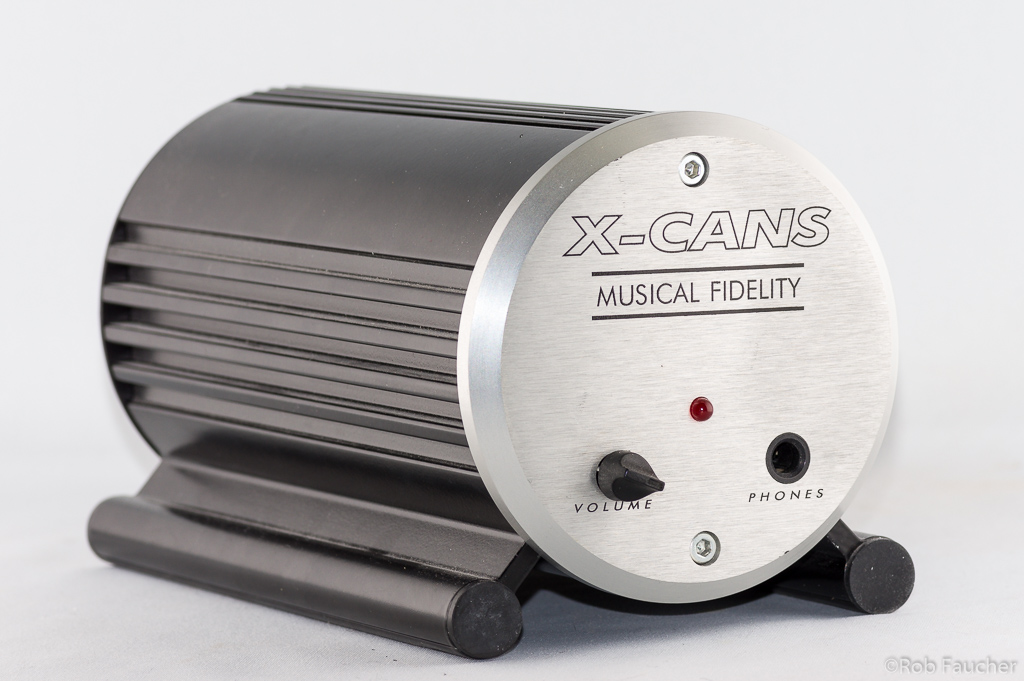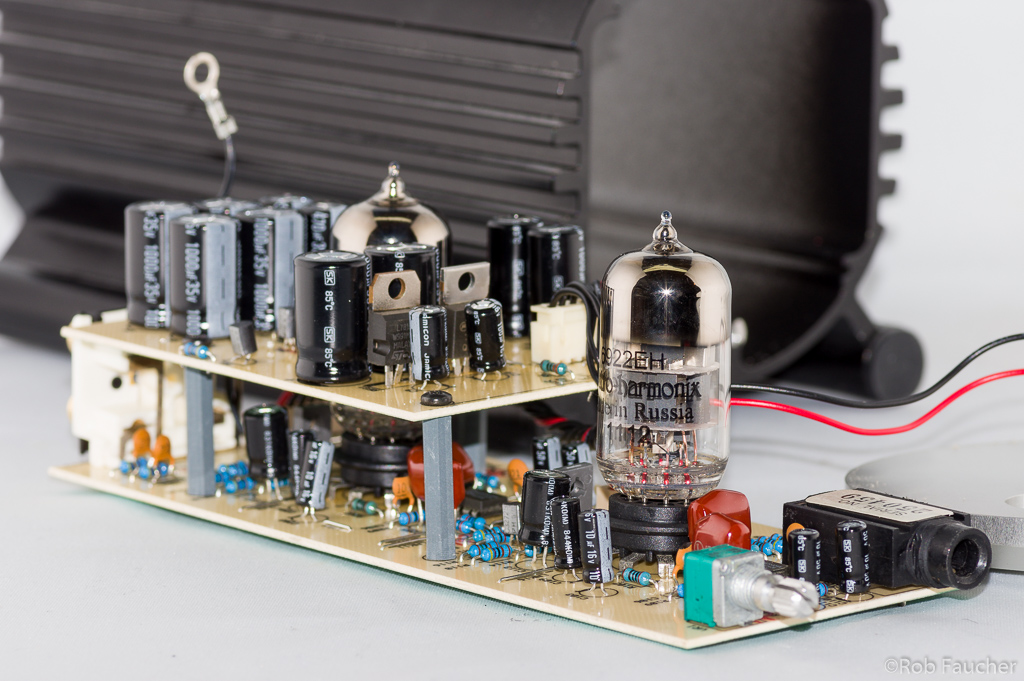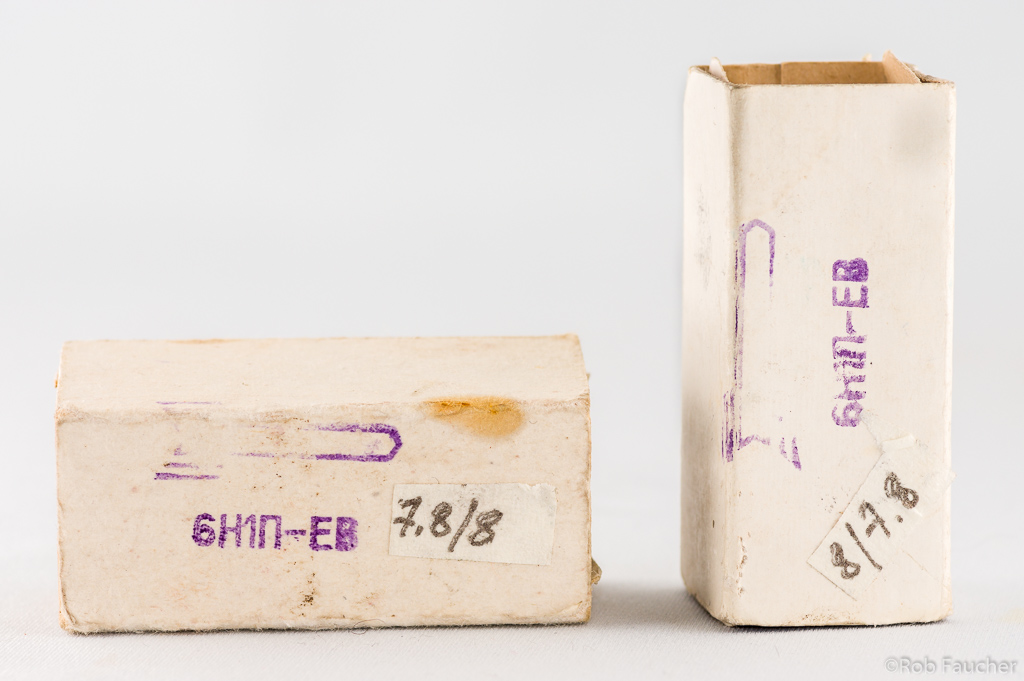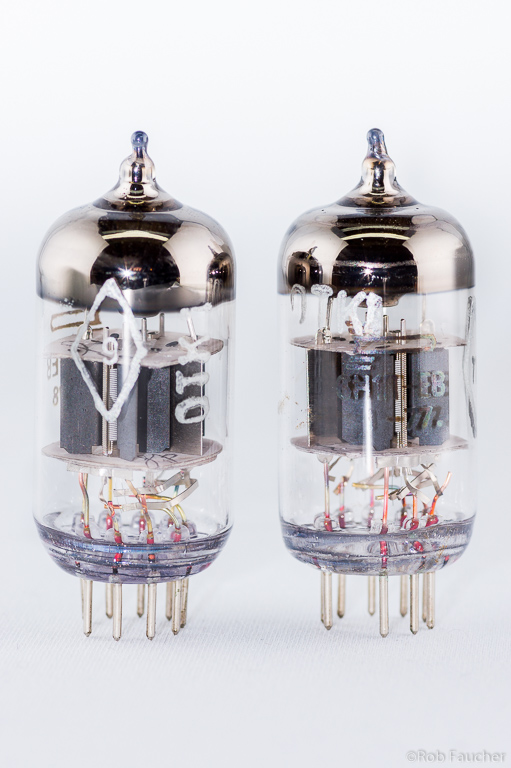This sort of odd pairing could only happen in a post cold war world. I am talking about replacing tubes in a British made headphone amplifier with vacuum tubes originally designed for the former Soviet military and space programme.
Resurrecting an Old X-Cans Headphone Amplifier
I was curious to see if these Soviet-era tubes would tame some of the brightness and sibilance of my headphone amplifier. I have an ageing Musical Fidelity X-Cans V1 headphone amplifier that has served me quite well over the years. When it was released, back in the the mid-nineties, it was well regarded as an affordable dedicated headphone amplifier which offered better sound than headphone jacks built in to amplifiers and AV receivers. Although X-Cans are not considered high-end, they are most certainly better than cheap headphone circuits built in to any integrated amp or AV receiver I have owned.

In the evenings, I now listen to music through headphones and back in 2015, I pulled the X-Cans out of a storage bin and discovered the original Phillips JAN 6922 tubes were kaput. There was a loud hum and barely any audio signal going through. I ordered some common Electro-Harmonix 6922 tubes and got the X-Cans working again. The sound is decent and it is good enough for lower end and “laid back” headphones.
Taming Brightness Caused by Electro-Harmonix “Black Box” Tubes
Now comes the rub, with higher quality headphones, the X-Cans can sound bright and there seems to be some artificial colouring to the higher registers in music. Especially with my Grado 325Es, which are very revealing with a forward midrange and a big sound stage. Just like a pair of electrostatic speakers, the Grado’s will accentuate any flaws in your system. When I plug the Grados into the headphone stage of my Asus Xonar STX soundcard, they sound more balanced. The Xonar has a really good headphone stage, but lacks the punch, power and sound stage of the X-Cans. Grado headphones are known for a prominent mid-range and some critics also find them a tad bright. They really need the right headphone stage to sound their best, namely something warm and not too forward.
I figured the generic Electro-Harmonix 6922 tubes could be the culprit. I seem to recall the X-Cans sounding less bright with the original Philips JAN 6922 tubes. After some googling, I discovered a common complaint against Electro-Harmonix tubes in hi-fi systems is the sound can be harsh and bright. These tubes are better suited to guitar amplifiers. Moreover, guitarists seeking a warmer sound are told to stay away from entry level Electro-Harmonix tubes. No worries, they are inexpensive, so no great loss.

Ideally, the best solution would be to dig deep into my pockets and get some vintage NOS tubes from Mullard or Telefunken. People with tube based headphone amps or pre-amps often give them glowing reviews. Alas, a set of those tubes would cost as much as buying a new and better headphone amp. It does not make sense to spend hundreds on rolling tubes for a budget component.
Vintage Soviet Era Tubes, An Affordable Solution
On some audio forums I was reading good reviews for Soviet-Era Voskhod “rocket label” 6922 tubes. Any available stock of those tubes will be used or “new old stock” (NOS). On Ebay, I found a Ukrainian vendor who is selling matched pairs of NOS 6922 Voskhod Rocket tubes for under $25 CAD shipped. His feedback rating is 100% for over 2300 transactions, so, I know I’m getting the real deal.

It took just over a month for the tubes to arrive and look decades old. I would fathom a guess these tubes were made any time between the late 1960’s and early 1980’s. They are military grade and for all I know, may be been designed for use in rockets or missiles. This means they should be immune to microphonic ringing caused by sound waves from speakers. Any space exploration geek knows that Voskhod rockets were used to send the first humans into orbit and deploy Zenit satellites. They flew from 1963 to 1976, so if the Soviet space programme ever used this series of vacuum tubes, that’s very cool in my books.
So, in a bizarre twist of old cold war enemies, I went to work to rip out modern Russian vacuum tubes from a British headphone amplifier and replace them with good old-fashioned communist tubes from the former USSR.

So, How Does it Sound
In short, they sound great!
Before evaluating new tubes, I keep them powered on for at least a day. This gives them time to break in a bit and provide a good indication of how they will sound over time. So after leaving the Voskhods on for 48 hours, it I decided to given them a listen and play a variety of music over a 3 hour period.
Gone is the harshness and exaggerated treble of the Electro-Harmonix tubes. The Voskhods sound fuller, warmer, detailed and less fatiguing. Even after a prolonged listening session, my ears were not tired. They have transformed the X-Cans into a better sounding headphone amplifier…one that I will be inclined to keep indefinitely.
The Voskhod tubes also tamed the brightness of the Grado 325E headphones. I really like those headphones, not only are they very comfortable, the midrange is fantastic and they render sound in a very detailed and musical way. The Grados allow me to hear sounds and music veiled by other headphones I own, such as the Focal Spirt One S and the Sennheiser HD-558. That said, the Grados are not perfect, some find them too bright around 2 to 3 Khz range. One solution is to modify or replace the pads and the other is to look for a warmer sounding headphone amp. I opted to do both. I wrapped the pads with electrical tape which took some edge off the high end and also added a bit more bass. I reasoned that tube rolling could help warm up my headphone amplifier and with the Voskhods I struck gold on a budget.
Now, I love my Grado 325E’s more than ever. The Voskhod tubes roll off the high end in a very pleasant way without sacrificing any soundstage or detail. To my ears, they sound more neutral than the Electro-Harmonix tubes, whilst retaining the fullness and three dimensional sound stage one would expect from a good tube amplifier.
Highly Recommended!


Ah, the electric sex of glowing vacuum tubes in audio equipment at night…..
In the early 90’s when I auditioned a couple of amps, a high end Yamaha and the Luxman LV-105u hybrid with vacuum tubes. I was immediately smitten by the sound quality of the Luxman when listening with headphones. No apparent “graininess” that I heard from the Yamaha. It was an easy decision after that and I still listen to the Luxman. Although not pure tube technology, the tubes do add a certain sonic quality to the output stage that I like. This was when CDs were just beginning to become the dominate audio format. I remember those CDs having a very “brassy” sound when compared to vinyl, at least to me. The audio technology has improved things, thank God, since then and the sound is better. The uniqueness of the Luxman helped make listening to early CDs more enjoyable.
Had it re-capped and a few other dodgy components replaced by the fine people at http://www.dnaelectronics.ca. This guy and his son are fanatics about vintage audio equipment and their goal is to rebuild and replace to exceed factory specs. I hear things now on my Luxman I never heard before when listening to really familiar music. Highly recommended.
Earlier, when I replaced the tubes in the Luxman, I found this place in Hamilton online: http://www.thetubestore.com and was pleased with the service.
You’re right about different tubes of the same type having different sonic qualities. A lot of guitar players will often audition different makes to get the sound they need. Someone once said that the perfect electric guitar sound makes you feel like when you smell bacon. If you check some of the online electric guitar forums, some interesting discussions and arguments about guitar/pickup/amp/tube combinations ensue.
Another reason why the Soviets used vacuum tubes in their military communications equipment was because vacuum tubes were almost not affected by the Electro Magnetic Pulse (EMP) following a nuclear detonation. EMPs create havoc with ICs (integrated circuits) that are in every bit of electronic communications used by the West then. Whether the West shields this stuff from EMPs, I’m not sure about. I’ve heard that vacuum tubes were still used until fairly recently in their aircraft for this reason. (That and it makes troubleshooting and repairs in the field a lot easier. Less requirement for highly skilled personnel or sophisticated test equipment).
Apparently, vacuum tubes from former Soviet satellites (like the Czech Republic and East Germany) are of better quality than from Russia, But all seem to agree the Chinese made stuff should be avoided.
I’m looking at my Fender Blues Junior guitar amp, a replica of the original 1950’s version including the Tweed exterior finish, that I bought in the late 90’s and it has Russian made vacuum tubes. Maybe Leo Fender would spin in his grave if he ever knew something he designed during the cold war and another example of western decadence now uses former Soviet technology.
Is this a crazy ol’ world or what?
Hi Terry,
Thank you for the great comments and insights. It’s a crazy new world indeed.
I agree that hybridizing transistors and tubes can provide a better sounding amplifier than pure solid state. It is a reasonable compromise for folks who cannot afford the bank depleting cost of a pure tube based amplifier. Having valves in the pre-amp stage will bring some of sonic qualities of tubes without driving the cost into the stratosphere. That’s why I have also tube-based phono pre-amp and a tube buffer stage from my DAC to the preamp. In a perfect world, I would have a really good tube power amplifier. Then again, I don’t have $10,000 burning a hole in my pocket 🙁
It is fascinating to see that tubes are enjoying a resurgence. There is a lot more than nostalgia that accounts this. Before transistors became the norm for audio equipment, tube amps were the only way to go. However, the quality of speakers back in the ’50s to ’70s was generally far inferior to what we have today. Furthermore the average turntable back then was crap compared to what we can buy now. Even a budget CD player or iPod is a better source than just anything available to consumers before transistors. It is only recently that we have speakers and sources of such high quality that the true goodness of tubes can be heard. IMHO the best thing transistor amps have going for them is much lower cost and weight and they can deliver very good sound for a modest cost. I liken an affordable transistor amp to a nice bottle of Chilean Cab-Sauvignon, whereas a really good tube amp is akin to a vintage Chateau Lafite Rothschild.
Other than the Voskhod’s, I also buy tubes from The Tube Store in Hamilton. They are a great company to deal with and very knowledgeable. They can recommend which tubes are better suited to hi-fi vs guitar amps and help you get the sound you want.
The quality of Russian tubes has come a long way the last several years as well. A number of Russian brands are owned by the American based New Sensor corporation, who also trade under the Svetlana & Electro-Harmonix names. If I recall, they started out making stomp boxes for guitar players decades ago.
Leo Fender may well be spinning around in his grave if he new Russian valves are powering Fender Amps. Then again, if he saw the prices of New Old Stock (NOS) American or British tubes, he would spin ever faster!
Cheers,
Rob
thanks for the review on these. I just set up a small headphone tube amp/ DAC combo with these tubes in them. this is my first delve into tubes for my listening set up in my office. This is a whole new ballgame and look forward to seeing how these break in!